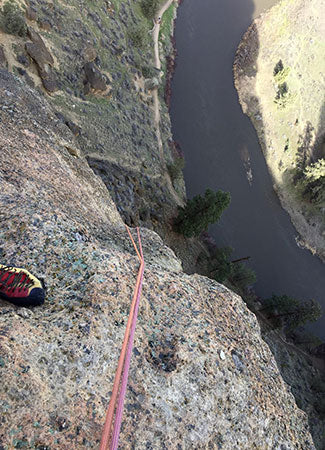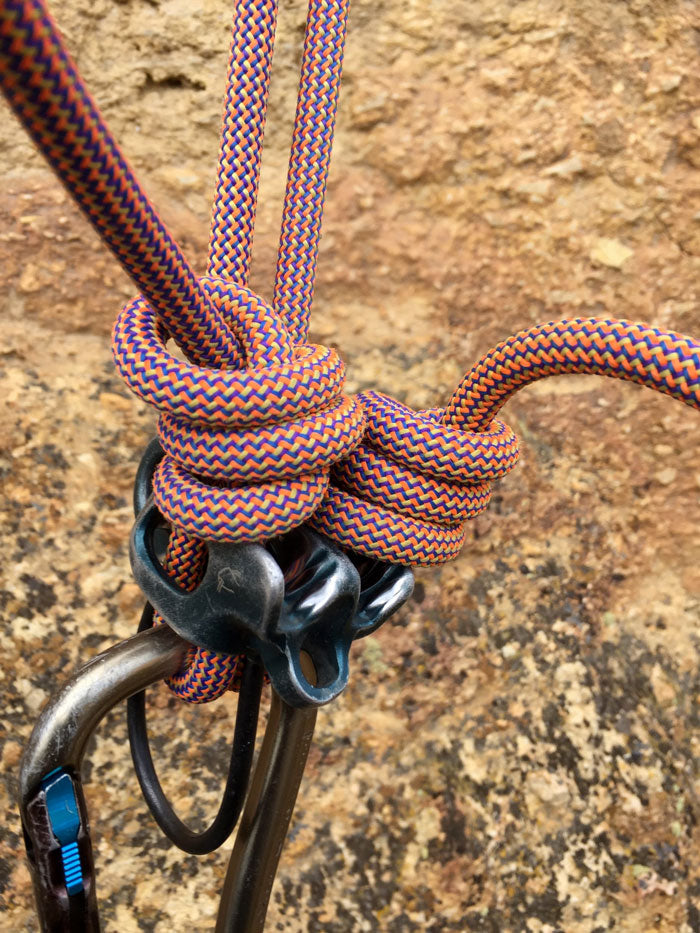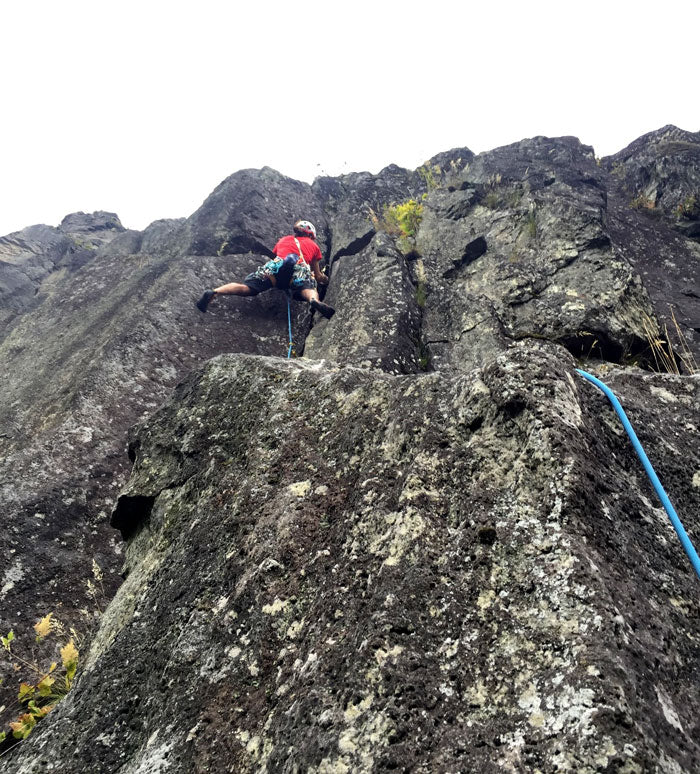
The Dirtbag Adventures: Episode 6 - What happens when you come to the end of your rope, literally?
Looking up, I could see only blue sky and the rocky bulge I'd just rappelled over. Looking down, I could only see the last twenty feet of my rope and the ground another sixty feet beyond. I keep sliding down, slowly, swinging left and right trying to find the next belay station. No luck.
 Looking down at what we thought was a legit, single rope rap route at Smith.
I'm a firm believer in tying stopper knots at the end of the rope when rappelling. “Rapping” isn't especially complicated, but the consequences are high and rappelling accidents are responsible for a large number of climbing deaths.
The idea behind stopper knots is that it “closes the system,” making it impossible for the climber to disconnect from the rope if they were to lose control. On this particular descent, I thought I was going to reach the ground and considered not tying the knots, but a bulge in the rock prevented me and my partner Gino from seeing our ropes hit the ground. We tied the knots just to be safe.
Looking down at what we thought was a legit, single rope rap route at Smith.
I'm a firm believer in tying stopper knots at the end of the rope when rappelling. “Rapping” isn't especially complicated, but the consequences are high and rappelling accidents are responsible for a large number of climbing deaths.
The idea behind stopper knots is that it “closes the system,” making it impossible for the climber to disconnect from the rope if they were to lose control. On this particular descent, I thought I was going to reach the ground and considered not tying the knots, but a bulge in the rock prevented me and my partner Gino from seeing our ropes hit the ground. We tied the knots just to be safe.
 I never planned to use the stopper knots in the of my rope…
By the time I reached the knots at the end of the rope I was already weighing potential next steps. I’d rapped on both ends of one seventy-meter dynamic rope, which meant I was probably forty meters below my partner and the rap station. With the gear I had on me, I could ascend the rope back up towards the rap station using one prussic and my GriGri, but this would be incredibly difficult and take at least twenty minutes. And we’d be right back where we started.
I swung back and forth as far as I could, looking for anything that might serve as an adequate anchor. I spotted a lone bolt, ten feet to my right. It wasn’t a rappel station, but the middle of a sport route. The bolt looked clean of corrosion, but the rock surface seemed to be wearing away and I didn’t feel like betting the future for my climbing partner Gino and myself on one piece of metal.
Where there’s one bolt there’s usually another, so I jugged up the rope and soon found the next bolt on this merciful, meandering sport route. It was twelve feet away from the first bolt, at a forty-five-degree angle to the left. I connected the two bolts with about five slings. If the lower bolt failed we’d be taking a cheese-grater swing across a bulgy face, and the voice in the back of my head kept telling me all the ways this anchor wasn't ideal...
But by this point I was over thinking things. These bolts were pretty new, regularly used, and any lead fall generates a hell of a lot more force than even two people rappelling. And bolts are really, really strong. The truth is we would have been fine rapping off that first bolt all by itself, but there was more to my thought process than we’ll be fine… I wanted security and redundancy, and it was worth the extra time.
Once I had the two bolts connected into one rappel station, I told Gino he could lower. He slid down, clipped in, and we pulled the rope. From here he easily lowered to the ground. I backtracked and removed most of the gear then bailed off the lower bolt, knowing that I wouldn’t shock load it. (Shock loading happens when a fall jerks on a single bolt or another piece of protection with a lot of force: since the rope is stretchy, being attached to a rope and falling rarely creates a shock load). Once on the ground, we packed up and headed back to camp.
I never planned to use the stopper knots in the of my rope…
By the time I reached the knots at the end of the rope I was already weighing potential next steps. I’d rapped on both ends of one seventy-meter dynamic rope, which meant I was probably forty meters below my partner and the rap station. With the gear I had on me, I could ascend the rope back up towards the rap station using one prussic and my GriGri, but this would be incredibly difficult and take at least twenty minutes. And we’d be right back where we started.
I swung back and forth as far as I could, looking for anything that might serve as an adequate anchor. I spotted a lone bolt, ten feet to my right. It wasn’t a rappel station, but the middle of a sport route. The bolt looked clean of corrosion, but the rock surface seemed to be wearing away and I didn’t feel like betting the future for my climbing partner Gino and myself on one piece of metal.
Where there’s one bolt there’s usually another, so I jugged up the rope and soon found the next bolt on this merciful, meandering sport route. It was twelve feet away from the first bolt, at a forty-five-degree angle to the left. I connected the two bolts with about five slings. If the lower bolt failed we’d be taking a cheese-grater swing across a bulgy face, and the voice in the back of my head kept telling me all the ways this anchor wasn't ideal...
But by this point I was over thinking things. These bolts were pretty new, regularly used, and any lead fall generates a hell of a lot more force than even two people rappelling. And bolts are really, really strong. The truth is we would have been fine rapping off that first bolt all by itself, but there was more to my thought process than we’ll be fine… I wanted security and redundancy, and it was worth the extra time.
Once I had the two bolts connected into one rappel station, I told Gino he could lower. He slid down, clipped in, and we pulled the rope. From here he easily lowered to the ground. I backtracked and removed most of the gear then bailed off the lower bolt, knowing that I wouldn’t shock load it. (Shock loading happens when a fall jerks on a single bolt or another piece of protection with a lot of force: since the rope is stretchy, being attached to a rope and falling rarely creates a shock load). Once on the ground, we packed up and headed back to camp.
 I took this photo of Gino leading the third pitch of Right Gull on Beacon Rock last week. I can't believe he still climbs with me!
People often say they “learned from the experience,” but I think that’s a passive approach to learning. Experiences often fill us with questions, not answer, and it’s up to us to us to go answer those questions. After this rappelling incident, I knew I’d gotten lucky so I went out to answer the question of what if I hadn't been lucky, and I learned a lot.
● How to use a guide-style belay device as an ascender.
● How to rig a rap in the middle of the rope, but rap on one strand-this makes ascending more efficient and allows for rappelling with a GriGri if necessary.
● Do the walk off whenever practical-it limits exposure to risk and may be quicker than rappelling.
● Carry a second prussic or an efficient ascender.
● Cary appropriate bail gear. I left a $14 locking carabiner behind when a $3 quick link would have been safer, and could have backed me up while ascending.
Okay, the second two are more like things I was reminded to do than things I learned, but that’s important too. Being able to change our opinions may be more beneficial than learning entirely new skills, depending on the situation. Either way, I learned a lot. And It didn’t turn into an accident report, which I’m very happy about!
I’d love to leave you with one hard and fast rule to avoid climbing accidents. Unfortunately, that’s not how life works, but I’ve got two general tips that might be worth your time.
● Give yourself the time you need: If you pack a headlamp and you're not dealing with warming snow conditions, then taking the time to improve an anchor or a rappel is no problem.
● Study up! If we’d trusted the guidebook about where to descent, we could have avoided this whole thing.
● Keep learning stuff. I can’t go back and improve what happened that day, but I did spend hours at home screwing around with ropes and gear, pulling myself across the floor, and I learned some things that will keep me safer next time!
● Have some fun with it! Learning how to solve a pickle then going out there and testing yourself is part of the joy of climbing!
Read all of the Dirtbag Adventures!
I took this photo of Gino leading the third pitch of Right Gull on Beacon Rock last week. I can't believe he still climbs with me!
People often say they “learned from the experience,” but I think that’s a passive approach to learning. Experiences often fill us with questions, not answer, and it’s up to us to us to go answer those questions. After this rappelling incident, I knew I’d gotten lucky so I went out to answer the question of what if I hadn't been lucky, and I learned a lot.
● How to use a guide-style belay device as an ascender.
● How to rig a rap in the middle of the rope, but rap on one strand-this makes ascending more efficient and allows for rappelling with a GriGri if necessary.
● Do the walk off whenever practical-it limits exposure to risk and may be quicker than rappelling.
● Carry a second prussic or an efficient ascender.
● Cary appropriate bail gear. I left a $14 locking carabiner behind when a $3 quick link would have been safer, and could have backed me up while ascending.
Okay, the second two are more like things I was reminded to do than things I learned, but that’s important too. Being able to change our opinions may be more beneficial than learning entirely new skills, depending on the situation. Either way, I learned a lot. And It didn’t turn into an accident report, which I’m very happy about!
I’d love to leave you with one hard and fast rule to avoid climbing accidents. Unfortunately, that’s not how life works, but I’ve got two general tips that might be worth your time.
● Give yourself the time you need: If you pack a headlamp and you're not dealing with warming snow conditions, then taking the time to improve an anchor or a rappel is no problem.
● Study up! If we’d trusted the guidebook about where to descent, we could have avoided this whole thing.
● Keep learning stuff. I can’t go back and improve what happened that day, but I did spend hours at home screwing around with ropes and gear, pulling myself across the floor, and I learned some things that will keep me safer next time!
● Have some fun with it! Learning how to solve a pickle then going out there and testing yourself is part of the joy of climbing!
Read all of the Dirtbag Adventures!
 Looking down at what we thought was a legit, single rope rap route at Smith.
I'm a firm believer in tying stopper knots at the end of the rope when rappelling. “Rapping” isn't especially complicated, but the consequences are high and rappelling accidents are responsible for a large number of climbing deaths.
The idea behind stopper knots is that it “closes the system,” making it impossible for the climber to disconnect from the rope if they were to lose control. On this particular descent, I thought I was going to reach the ground and considered not tying the knots, but a bulge in the rock prevented me and my partner Gino from seeing our ropes hit the ground. We tied the knots just to be safe.
Looking down at what we thought was a legit, single rope rap route at Smith.
I'm a firm believer in tying stopper knots at the end of the rope when rappelling. “Rapping” isn't especially complicated, but the consequences are high and rappelling accidents are responsible for a large number of climbing deaths.
The idea behind stopper knots is that it “closes the system,” making it impossible for the climber to disconnect from the rope if they were to lose control. On this particular descent, I thought I was going to reach the ground and considered not tying the knots, but a bulge in the rock prevented me and my partner Gino from seeing our ropes hit the ground. We tied the knots just to be safe.
 I never planned to use the stopper knots in the of my rope…
By the time I reached the knots at the end of the rope I was already weighing potential next steps. I’d rapped on both ends of one seventy-meter dynamic rope, which meant I was probably forty meters below my partner and the rap station. With the gear I had on me, I could ascend the rope back up towards the rap station using one prussic and my GriGri, but this would be incredibly difficult and take at least twenty minutes. And we’d be right back where we started.
I swung back and forth as far as I could, looking for anything that might serve as an adequate anchor. I spotted a lone bolt, ten feet to my right. It wasn’t a rappel station, but the middle of a sport route. The bolt looked clean of corrosion, but the rock surface seemed to be wearing away and I didn’t feel like betting the future for my climbing partner Gino and myself on one piece of metal.
Where there’s one bolt there’s usually another, so I jugged up the rope and soon found the next bolt on this merciful, meandering sport route. It was twelve feet away from the first bolt, at a forty-five-degree angle to the left. I connected the two bolts with about five slings. If the lower bolt failed we’d be taking a cheese-grater swing across a bulgy face, and the voice in the back of my head kept telling me all the ways this anchor wasn't ideal...
But by this point I was over thinking things. These bolts were pretty new, regularly used, and any lead fall generates a hell of a lot more force than even two people rappelling. And bolts are really, really strong. The truth is we would have been fine rapping off that first bolt all by itself, but there was more to my thought process than we’ll be fine… I wanted security and redundancy, and it was worth the extra time.
Once I had the two bolts connected into one rappel station, I told Gino he could lower. He slid down, clipped in, and we pulled the rope. From here he easily lowered to the ground. I backtracked and removed most of the gear then bailed off the lower bolt, knowing that I wouldn’t shock load it. (Shock loading happens when a fall jerks on a single bolt or another piece of protection with a lot of force: since the rope is stretchy, being attached to a rope and falling rarely creates a shock load). Once on the ground, we packed up and headed back to camp.
I never planned to use the stopper knots in the of my rope…
By the time I reached the knots at the end of the rope I was already weighing potential next steps. I’d rapped on both ends of one seventy-meter dynamic rope, which meant I was probably forty meters below my partner and the rap station. With the gear I had on me, I could ascend the rope back up towards the rap station using one prussic and my GriGri, but this would be incredibly difficult and take at least twenty minutes. And we’d be right back where we started.
I swung back and forth as far as I could, looking for anything that might serve as an adequate anchor. I spotted a lone bolt, ten feet to my right. It wasn’t a rappel station, but the middle of a sport route. The bolt looked clean of corrosion, but the rock surface seemed to be wearing away and I didn’t feel like betting the future for my climbing partner Gino and myself on one piece of metal.
Where there’s one bolt there’s usually another, so I jugged up the rope and soon found the next bolt on this merciful, meandering sport route. It was twelve feet away from the first bolt, at a forty-five-degree angle to the left. I connected the two bolts with about five slings. If the lower bolt failed we’d be taking a cheese-grater swing across a bulgy face, and the voice in the back of my head kept telling me all the ways this anchor wasn't ideal...
But by this point I was over thinking things. These bolts were pretty new, regularly used, and any lead fall generates a hell of a lot more force than even two people rappelling. And bolts are really, really strong. The truth is we would have been fine rapping off that first bolt all by itself, but there was more to my thought process than we’ll be fine… I wanted security and redundancy, and it was worth the extra time.
Once I had the two bolts connected into one rappel station, I told Gino he could lower. He slid down, clipped in, and we pulled the rope. From here he easily lowered to the ground. I backtracked and removed most of the gear then bailed off the lower bolt, knowing that I wouldn’t shock load it. (Shock loading happens when a fall jerks on a single bolt or another piece of protection with a lot of force: since the rope is stretchy, being attached to a rope and falling rarely creates a shock load). Once on the ground, we packed up and headed back to camp.
 I took this photo of Gino leading the third pitch of Right Gull on Beacon Rock last week. I can't believe he still climbs with me!
People often say they “learned from the experience,” but I think that’s a passive approach to learning. Experiences often fill us with questions, not answer, and it’s up to us to us to go answer those questions. After this rappelling incident, I knew I’d gotten lucky so I went out to answer the question of what if I hadn't been lucky, and I learned a lot.
● How to use a guide-style belay device as an ascender.
● How to rig a rap in the middle of the rope, but rap on one strand-this makes ascending more efficient and allows for rappelling with a GriGri if necessary.
● Do the walk off whenever practical-it limits exposure to risk and may be quicker than rappelling.
● Carry a second prussic or an efficient ascender.
● Cary appropriate bail gear. I left a $14 locking carabiner behind when a $3 quick link would have been safer, and could have backed me up while ascending.
Okay, the second two are more like things I was reminded to do than things I learned, but that’s important too. Being able to change our opinions may be more beneficial than learning entirely new skills, depending on the situation. Either way, I learned a lot. And It didn’t turn into an accident report, which I’m very happy about!
I’d love to leave you with one hard and fast rule to avoid climbing accidents. Unfortunately, that’s not how life works, but I’ve got two general tips that might be worth your time.
● Give yourself the time you need: If you pack a headlamp and you're not dealing with warming snow conditions, then taking the time to improve an anchor or a rappel is no problem.
● Study up! If we’d trusted the guidebook about where to descent, we could have avoided this whole thing.
● Keep learning stuff. I can’t go back and improve what happened that day, but I did spend hours at home screwing around with ropes and gear, pulling myself across the floor, and I learned some things that will keep me safer next time!
● Have some fun with it! Learning how to solve a pickle then going out there and testing yourself is part of the joy of climbing!
Read all of the Dirtbag Adventures!
I took this photo of Gino leading the third pitch of Right Gull on Beacon Rock last week. I can't believe he still climbs with me!
People often say they “learned from the experience,” but I think that’s a passive approach to learning. Experiences often fill us with questions, not answer, and it’s up to us to us to go answer those questions. After this rappelling incident, I knew I’d gotten lucky so I went out to answer the question of what if I hadn't been lucky, and I learned a lot.
● How to use a guide-style belay device as an ascender.
● How to rig a rap in the middle of the rope, but rap on one strand-this makes ascending more efficient and allows for rappelling with a GriGri if necessary.
● Do the walk off whenever practical-it limits exposure to risk and may be quicker than rappelling.
● Carry a second prussic or an efficient ascender.
● Cary appropriate bail gear. I left a $14 locking carabiner behind when a $3 quick link would have been safer, and could have backed me up while ascending.
Okay, the second two are more like things I was reminded to do than things I learned, but that’s important too. Being able to change our opinions may be more beneficial than learning entirely new skills, depending on the situation. Either way, I learned a lot. And It didn’t turn into an accident report, which I’m very happy about!
I’d love to leave you with one hard and fast rule to avoid climbing accidents. Unfortunately, that’s not how life works, but I’ve got two general tips that might be worth your time.
● Give yourself the time you need: If you pack a headlamp and you're not dealing with warming snow conditions, then taking the time to improve an anchor or a rappel is no problem.
● Study up! If we’d trusted the guidebook about where to descent, we could have avoided this whole thing.
● Keep learning stuff. I can’t go back and improve what happened that day, but I did spend hours at home screwing around with ropes and gear, pulling myself across the floor, and I learned some things that will keep me safer next time!
● Have some fun with it! Learning how to solve a pickle then going out there and testing yourself is part of the joy of climbing!
Read all of the Dirtbag Adventures!

